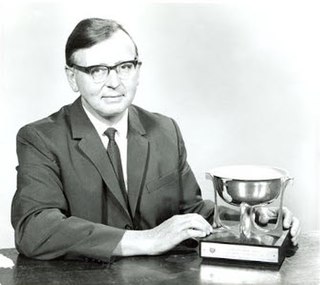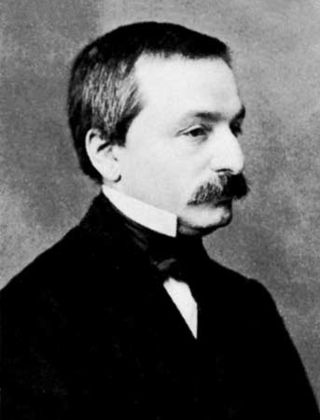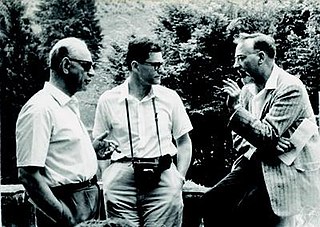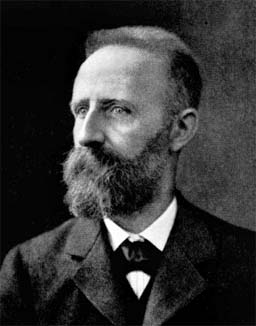Related Research Articles

James Hardy Wilkinson FRS was a prominent figure in the field of numerical analysis, a field at the boundary of applied mathematics and computer science particularly useful to physics and engineering.

Leopold Kronecker was a German mathematician who worked on number theory, algebra and logic. He criticized Georg Cantor's work on set theory, and was quoted by Weber (1893) as having said, "Die ganzen Zahlen hat der liebe Gott gemacht, alles andere ist Menschenwerk". Kronecker was a student and life-long friend of Ernst Kummer.

Kurt August Hirsch was a German mathematician who moved to England to escape the Nazi persecution of Jews. His research was in group theory. He also worked to reform mathematics education and became a county chess champion. The Hirsch length and Hirsch–Plotkin radical are named after him.

Constantin Marie Le Paige was a Belgian mathematician.
Mark Aronovich Naimark was a Soviet mathematician who made important contributions to functional analysis and mathematical physics.
Pierre Samuel was a French mathematician, known for his work in commutative algebra and its applications to algebraic geometry. The two-volume work Commutative Algebra that he wrote with Oscar Zariski is a classic. Other books of his covered projective geometry and algebraic number theory.
John Mackintosh Howie was a Scottish mathematician and prominent semigroup theorist.

Otto Schreier was a Jewish-Austrian mathematician who made major contributions in combinatorial group theory and in the topology of Lie groups.

Ernst Sigismund Fischer was a mathematician born in Vienna, Austria. He worked alongside both Mertens and Minkowski at the Universities of Vienna and Zurich, respectively. He later became professor at the University of Erlangen, where he worked with Emmy Noether.

William Browder is an American mathematician, specializing in algebraic topology, differential topology and differential geometry. Browder was one of the pioneers with Sergei Novikov, Dennis Sullivan and C. T. C. Wall of the surgery theory method for classifying high-dimensional manifolds. He served as president of the American Mathematical Society until 1990.

James Alexander "Sandy" Green FRS was a mathematician and Professor at the Mathematics Institute at the University of Warwick, who worked in the field of representation theory.
Brian Hartley was a British mathematician specialising in group theory.
The following is a timeline of key developments of algebra:

George Chrystal FRSE FRS was a Scottish mathematician. He is primarily known for his books on algebra and his studies of seiches which earned him a Gold Medal from the Royal Society of London that was confirmed shortly after his death.
Gordon Bamford Preston was an English mathematician best known for his work on semigroups. He received his D.Phil. in mathematics in 1954 from Magdalen College, Oxford.
Alexei Ivanovich Kostrikin was a Russian mathematician, specializing in algebra and algebraic geometry.

Walter Ledermann FRSE was a German and British mathematician who worked on matrix theory, group theory, homological algebra, number theory, statistics, and stochastic processes. He was elected to the Royal Society of Edinburgh in 1944.
Lancelot Stephen Bosanquet was a British mathematician who worked in analysis, especially Fourier series.
John Williamson was a Scottish mathematician who worked in the fields of algebra, invariant theory, and linear algebra. Among other contributions, he is known for the Williamson construction of Hadamard matrices. Williamson graduated from the University of Edinburgh with first-class honours in 1922. Awarded a Commonwealth Fellowship in 1925, he studied at the University of Chicago under the direction of L. E. Dickson and E. H. Moore, receiving the Ph.D. in 1927. He held a Lectureship in Mathematics at the University of St Andrews and an Associate Professorship in Mathematics at Johns Hopkins University.

George Cunliffe McVittie (1904–1988) was a British mathematician and cosmologist. He is best known for his contributions towards radio astronomy.
References
- 1 2 3 "www-groups.mcs.st-andrews.ac.uk/~edmund/CV.html". www-groups.mcs.st-andrews.ac.uk. Archived from the original on 14 April 2021. Retrieved 6 September 2020.
- ↑ Current Fellows. Archived 27 June 2004 at the Wayback Machine Royal Society of Edinburgh. Accessed 8 November 2008.
- ↑ Colm Mulcahy: MacTutor History of Mathematics website creators honoured by LMS. The Aperiodical, 19. July 2015
- ↑ Edmund Frederick Robertson Math Genealogy Project
- ↑ "Edmund Robertson's Personal Home Page". turnbull.mcs.st-and.ac.uk. Archived from the original on 9 January 2002. Retrieved 24 July 2021.